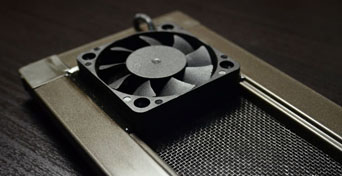Environmental: Cooling & Airflow Supplies
For Bioactive Terrariums & Live Vivariums
About Cooling
Your ambient room temperature is the biggest decision maker when it comes to purchasing additional cooling supplies. If the room your vivarium will be kept in remains between 67-74F year round, additional supplies usually aren't necessary! Some lighting kits run hotter than others, and our recommended options (and their heat ratings) are described on our Lighting Kits pages. We recommend considering both your ambient room temperature and your lighting kit when determining whether or not a cooling device will be necessary. If ambient room temperature will be 10-15°f cooler than the max recommended for the species of animal you are working with, you almost certainly won't need to worry about additional cooling for your vivarium. Especially if you'll be using one of our cooler-running lighting kits. 
About Keeping Glass Clear
Most enthusiasts think "cooling" when fans are mentioned, but they are also useful for super-humid vivariums where condensation on the glass becomes an issue. In that case, these fans can move enough air through the enclosure to prevent condensation build-up completely. If your enclosure isn't expected to remain over 85% R/H, condensation probably won't be a concern, so you can skip the added expense. On a related note, a little condensation in the early morning isn't something we generally try to prevent at NEHERP. Think of it like morning dew. 
Zoo Med Aquacool Fan
Our favorite terrarium cooling fan




Zoo Med Repti Cooler
An evaporative cooler for terrariums




DIY Fan Solutions
Enthusiast-driven solutions can work great!


NEHERP Staff Recommendation:
We can't compete on price when it comes to DIY-components for custom fan kits, but we do have a few recommendations for things to consider & avoid on Amazon. Brushless fans are typically the way to go. Most are small, energy efficient, and low-noise units for moving a small amount of air. Calculating how much air movement you need in CFM (cubic feet per minute) can be tricky, so having some sort of adjustable running speed can be helpful. Especially since different times of the year may require different fan speeds. For safety, we recommend sticking to low-voltage units. Fans which run on 12V or 5.5V are a good bet, with 5.5V being a typical USB Charger's amount of voltage. We don't recommend using a 110V (line voltage) fan for this purpose, as doing so carries far more risk than a low-voltage solution. In addition, we also recommend searching for an IP65-IP68 rated fan. These ratings give you added peace of mind for use around a small amount of water and dust. In summary, a solid solution will be a 5.5V or 12V fan which carries an IP65 rating (or better) and has an adjustable output. While there are many hobbyists mounting these inside of a terrarium, that's not generally something we do at NEHERP. If that's the plan, be extra careful to ensure the fan's intake and exhaust paths are kept clear of obstructions, and have a mesh cover tight enough to protect the inhabitants from contacting the spinning fan. Safety note: Always follow the manufacturer's recommendations and use caution when working with electronic products.
Things To Avoid:
• 110V / 120V Operation
• No power adapter included
• No IP67/IP68 or moisture rating
• Pigtails in lieu of plugged adapters
• "High Flow" or large brushless fans
Things To Look For:
• 5V, 5.5V, or 12V Operation
• Power Adapter Included
• Adjustable Speed Controller
• IP67 or IP68 Rating
• 20-40MM for smaller terrariums
• 50-70MM for larger terrariums
We don't carry these at NEHERP, so please check them out at the above link.
As an Amazon Associate, our small business earns from qualifying purchases ♥











 Environmental:
Environmental: Environmental:
Environmental: Environmental:
Environmental: Environmental:
Environmental: